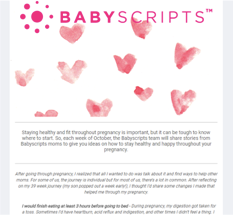
Customer engagement is a challenging metric to measure and improve. In healthcare, customer engagement takes on new importance because customers are patients, and engagement is an opportunity to change patient behavior and outcomes for the better.
At Babyscripts our mission is to improve pregnancy. We do that by helping healthcare systems individualize and streamline prenatal care by deploying risk-based modules and modifying patient behavior. For us, customer engagement can mean the difference between a healthy, full-term pregnancy and a high-risk, potentially life threatening pregnancy.
Key to a healthy pregnancy — and something that doesn’t get too much airtime — is gaining the right amount of weight from the right sources. Recently released maternal health statistics point to weight as a contributor to the staggering maternal morbidity rates in the United States. So as the holidays, a time for family, friends, and overeating, fast approach, we crafted a strategy to improve patient engagement through weight gain education and support.
- What does patient engagement mean? We engage patients through a mobile application which connects patients to guided remote monitoring and education tailored to each patient’s pregnancy. We measure engagement by understanding each interaction a patient has with the mobile app, from number of sessions and time between sessions all the down to the times patients tend to open the app and how long they sped on each activity within the app.
- How will we improve engagement? We decided to use a combination of email, in-app messages, and push notifications to engage patients. To customize each patient’s messaging, we leveraged the data we’ve collected on patient preferences and behavior to determine what method would work at what time.
- An email campaign with a call to action to continue reading in the app
- In-app messages with short and sweet information
- Push notifications with a call to action to continue learning in a specific section of the app
To measure improvement, we compared the engagement of patients who received the email, in-app, and push notifications to a control group of 25% of our patients who did not receive any messaging. - Who would we target for improvement? We wanted to test out which method worked best, but didn’t want to bombard our patients with communication — it’s a delicate balance. So, we decided to split up the outreach into the following categories.
- Email campaign. We sent the series of emails to 25% of our patients from October 11th to October 30th.
- In-app. We sent 25% of patients an in-app notification on Halloween.
- Push notifications. We sent 25% of patients a push notification on Halloween.
The results
Email Campaign. We worked with our certified nutritionist and fitness coach, who specializes in pregnancy, to help craft a series of emails that offered patients quick tips on how to stay healthy and fit throughout pregnancy. The emails were sent every Tuesday of October.

Email campaign
With each subsequent email that was sent, the open rate grew. The first email we sent had an open-rate of 31%, and our last was opened by 48% of patients who received them. The Healthcare industry’s average email open rate is 22%. However, we didn’t see a significant uptick in users going into the app from the emails.

In-app messages. We delivered one in-app message on Halloween reminding patients that a great way to avoid the Halloween candy binge was the keep healthy alternatives like dark chocolate and caramel covered-apples accessible.
In the 14 days after the in-app message was sent, we observed an increase of 3.1 app sessions per patient.
- Patients with in-app had an average of 10 sessions.
- Patients without the in-app had an average of 6.9 sessions.

Push notification
Push notifications. We delivered push notifications that directed patients to fitness and healthy eating resources inside our app.
We noticed that 34% of patients who received the push notification went on to open the app that same day. Whereas, only 16% of patients who did not receive the push notification opened the app that same day.
Conclusion. In our weight gain education campaign, patients were more likely to have additional sessions when they received an in-app message and/or push notification, than patients who did not receive any messaging. For us, each additional session is another opportunity for us to interact with a patient and increase her understanding of her health and how she can improve it.
With this campaign as a guide, the Babyscripts team is working to incorporate more event-based education into our programs to continue to drive patient education and clinical priorities (set by each patient’s practice), and sustain patient engagement for the entirety of the pregnancy.

Submit a comment